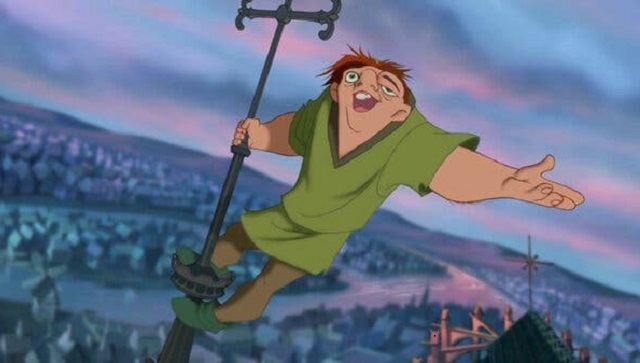They know exactly what they got away with. “That’s the most R-rated G you will ever see in your life,” said Tab Murphy, a screenwriter of Disney’s animated The Hunchback of Notre Dame, which was released 25 years ago this month. “Thousands of dollars must have changed hands somewhere, I’m sure,” joked Gary Trousdale, who directed the film with Kirk Wise. However it came about, a ratings board made up of parents decided that a film with a musical number about lust and hellfire and a plot that involves the threat of genocide against Gypsies was appropriate for a general audience. Maybe the reason had to do with the studio: Nearly all of Disney’s hand-drawn animated movies had been rated G up to that point. Maybe it was the marketing, which presented “Hunchback” as a complete departure from the dark Victor Hugo novel on which it was based, reframing it like a carnival with the tagline “Join the party!” Maybe the higher-ups at Disney exerted pressure, convinced a PG rating would hurt the box office take. (“It was a G rating or bust,” Wise said.) But the fact that what is arguably Disney’s darkest animated movie earned a rating on par with Cinderella reflects the subjectivity of the rating system — and how much parents’ tastes have changed over the years. “PG today is the equivalent of what G was in the 1990s,” Wise said. Trousdale added, “Nowadays, you can’t even smoke in a G film.” But one scene, in particular, defies explanation.
Though it was never stated explicitly, Wise said a G rating was the expectation. “The studio felt anything above a G would threaten the film’s box office,” he said. “This was before Shrek, or movies that made a PG rating in animation commonplace.” A G-rated film, according to the Motion Picture Association of America system, which was introduced in 1968, “contains nothing in theme, language, nudity, sex, violence or other matters that, in the view of the Rating Board, would offend parents whose younger children view the motion picture.” Some snippets of language, it says, “may go beyond polite conversation but they are common everyday expressions.” “We never thought we’d get away with the term ‘hellfire,’” Trousdale said. The first cut of Hunchback indeed didn’t pass muster for a G — but it wasn’t the use of the word “hell” or “damnation” that the board took issue with. It was the sound effects. In the Hellfire number, imagined as a nightmarish, hallucinogenic sequence, Frollo is tormented by hooded, red-robed figures that reflect his slipping grip on reality. “This burning desire,” he sings, gazing at a dancing Esmeralda figure in his fireplace, “is turning me to sin.” The ratings board was uncomfortable with the word “sin,” Trousdale said. But the sequence was already animated, and the soundtrack recorded, so they couldn’t change the lyric. Then Hahn came up with a solution: Make the “Whoosh!” when the hooded judges rush up from the floor a little louder so it would drown out the “sin.” It worked, Trousdale said. But what ultimately got the film its G rating, Wise said, was a change so tiny that “you’ll never believe this.” In the scene where Frollo sneaks up behind Esmeralda and sniffs her hair, the ratings board thought the sniff was “too suggestive,” he said. “They were like, ‘Could you lower the volume of that?’” he said. “And we did, and it got the G rating.” Neither the posters nor the trailers hinted at the darker themes. “There was definitely a huuuuuge effort to emphasise the lighthearted aspects of ‘Hunchback,’” Menken said, laughing. When the film, which cost $70 million to make before marketing, opened on 21 June, 1996, it was a bit of a disappointment at the box office, grossing about $100.1 million domestically. Trousdale said they did get some pushback from parents’ groups about the G rating. “They were saying ‘You tricked us; you deceived us,’” he said. “The marketing was all the happy stuff and ‘Come to the Feast of Fools; it’s a party!’ with talking gargoyles, confetti and pies in the face. And then that wasn’t the film, and people were really pissed off.” Tom Zigo, a spokesman for the Classification and Rating Administration, which administers the rating system, said that he could not speak about the specifics of the Hunchback G, but that it was “very possible” that a movie rated 25 years ago would receive a different rating today.
Hahn, Menken, Murphy, Trousdale and Wise all agreed there would be no chance of the film getting a G rating today — or even, Murphy suggested, being made at all.
“Disney was willing to take some chances in that movie that I don’t think they’d take today,” he said. “That’s a PG-13 in my book.” Yet the movie has stood the test of time — Frollo, Wise noted, feels like a “very contemporary” villain in the #MeToo era — and remains a favourite among young adults who rewatch and discover references they missed the first time around. “I’ve read posts on fan pages from a few fans in their mid-20s and 30s who were pretty young when they saw this,” Trousdale said. “They’re like, ‘Yeah, this just messed me up when I saw it as a kid, but I still love it.’” Menken said Hellfire pushed the envelope more in terms of what Disney does than any song he’s ever written. “Maybe, in retrospect, Hunchback was a bridge too far,” he said. “But God, am I glad they took that bridge too far.” Sarah Bahr c.2021 The New York Times Company


)
)
)
)
)
)
)
)
)



